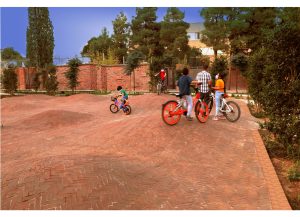نوع مقاله : مقالۀ پژوهشی
نویسندگان
- عباس کریمی 1
- آرزو خانپور 2
1 مربی، دانشکده هنرهای صناعی، دانشگاه هنر اسلامی تبریز، تبریز، ایران.
2 استادیار، دانشکده هنرهای صناعی، دانشگاه هنر اسلامی تبریز، تبریز، ایران.

باغ نظر (ماهنامه)
دوره 18، شماره 103
دی 1400
صفحه 5-16
بیان مسئله: شیشهگری سنتی ایران در دوره صفوی پس از چند دهه رکود با کمک شیشهگران ونیزی که توسط شاهعباس به ایران دعوت شده بودند، مجدداً احیا میشود. اشکدانهای شیشه مجموعه صراحیهای هستند که نمونههای ساخته شده آنها در دوره قاجار در اغلب موزههای جهان به عنوان شاخصه شیشه ایرانی شناخته میشود. موزه متروپولیتن مجموعه ارزشمندی از این نوع صراحی (اشکدان) متعلق به دوره قاجار را در اختیار دارد که در این مقاله به بررسی فرم و کاربرد این مجموعه پرداخته شده است.
هدف پژوهش: هدف این مقاله مطالعه فرم و کاربرد اشکدانهای موزه متروپولیتن به منظور چیستی و چرایی ساخت آن، با طرح این پرسش است که فرم صراحیهای موسوم به اشکدان چه کاربردی داشته و چگونه و از چه دورهای در هنر شیشه ایرانی متداول شده است؟ و به بیان این فرضیه میپردازد که فرم اشکدان از دوره صفوی با ورود شیشهگران ونیزی و تأثیر آنها بر شیشه ایرانی شکل گرفته و کاربرد آن با گذر زمان، متناسب با شرایط فرهنگی و اجتماعی هر دوره صورتهای متفاوتی به خود میگیرد.
روش پژوهش: این مقاله از نظر راهبرد از نوع کیفی و از لحاظ هدف، کاربردی است که به شیوه توصیفی-تحلیلی و با استفاده از منابع کتابخانهای و دادههای حاصل از مطالعات میدانی و مشاهدات عمیق نگارندگان به انجام رسیده است. جامعه مورد مطالعه مجموعه صراحیهای موسوم به اشکدان متعلق به دوره قاجار است که ده نمونه از اشکدانهای موجود در موزه متروپولیتن به روش نمونهگیری غیراحتمالی وضعی (ترجیحی) انتخاب شده است.
نتیجهگیری: در نتایج حاصل از این پژوهش در پاسخ به چیستی اشکدانها دریافت میشود که کاربرد این آثار با عنوانی که براساس فرم بدان اطلاق شده است مناسبت چندانی ندارند. ساخت صراحیهای گردن قو با اقتباس از نمونههای غربی وارداتی و با کاربرد ظرف نگهداری شراب، گلاب و گل متداول میشود که از دوره قاجار با عنوان اشکدان با کاربرد تزیین از شاخصترین آثار هنر شیشه ایرانی در جهان مورد توجه قرار میگیرد. فرضیه طرحشده مبتنی بر تأثیر شیشهگران ونیزی بر هنر شیشه ایرانی در این پژوهش صحیح است. فرم گردن و دهانه اشکدانها تحت تأثیر آموزه شیشهگران ونیزی ملهم از کاترولفهای رومی بوده و براساس توصیفات موجود از دوره صفوی متداول شده است. نمونههای موجود در اغلب موزههای جهان و به خصوص در موزه متروپولیتن متعلق به دوره قاجار است.
عنوان مقاله [English]
Investigating the Form and Application of Carafes Known as Ashkdan in the Collection of the Metropolitan Museum
نویسندگان [English]
- Abbas Karimi 1
- Arezoo Khanpour 2
چکیده [English]
Problem statement: Traditional Iranian glassmaking in the Safavid period was revived after several decades of stagnation with the help of Venetian glassmakers who was invited to Iran by Shah Abbas. Glass Ashkdans are a collection of carafes and those that were made during Qajar period are found in most museums around the world as the hallmarks of Iranian glass art. The Metropolitan Museum has a valuable collection of this type of carafe (Ashkdan) belonging to the Qajar period, whose form and application are investigated in the present study.
Research objective: The present study aims to investigate the form and application of Ashkdans in the Metropolitan Museum to answer the two questions: 1. what was the use of Ashkdan? and 2. how and when did Ashkdan become prominent in Iranian glass art? It also expresses the hypothesis that Ashkdan was first introduced by Venetian glassmakers into Iranian Glass art during the Safavid period, and its application varied over time, according to the cultural and social conditions of each period.
Research method: This applied qualitative descriptive-analytical study was conducted by using bibliographic databases and gathering the data from the field studies and through in-depth observations of the authors. The research sample is a collection of carafes referred to as Ashkdan belonging to the Qajar period. Ten samples of Ashkdans in the Metropolitan Museum were selected through a non-probability sampling method.
Conclusion: Based on the results, the application of Ashkdan is not related to its title and is based on its form. Making swan neck bottles became prominent by adaptation from western samples and using them as containers for wine, rosewater, and flower. Ashkdan, one of the most prominent works of Iranian glass art in the world, has received much attention since the Qajar period. The hypothesis on the influence of Venetian glassmakers on Iranian glass art in this study was approved. The form of the necks and mouths of the Ashkdans was influenced by the teachings of Venetian glassmakers, inspired by the Roman Kuttrolfs, and became common according to existing descriptions from the Safavid period. The samples in most museums around the world, especially in the Metropolitan Museum, belong to the Qajar period.
مطالعه فرم و کاربرد صراحی هایی موسوم به اشکدان در مجموعه موزه متروپولیتن اصل مقاله 957.25 k
صاحب امتیاز: پژوهشکده هنر، معماری و شهرسازی نظر
مدیر مسئول: دکتر سید امیر منصوری
سردبیر: دکتر احمد پوراحمد
دوره انتشار: ماهنامه
شاپا چاپی: 1735-9635
شاپا الکترونیکی: 2251-7197













